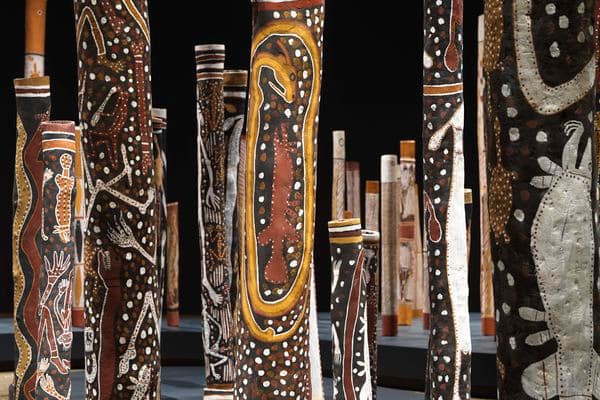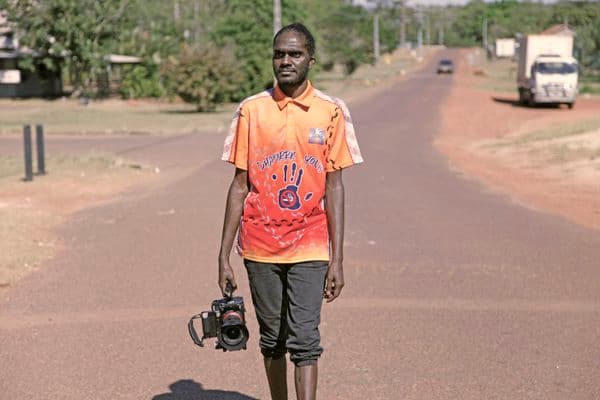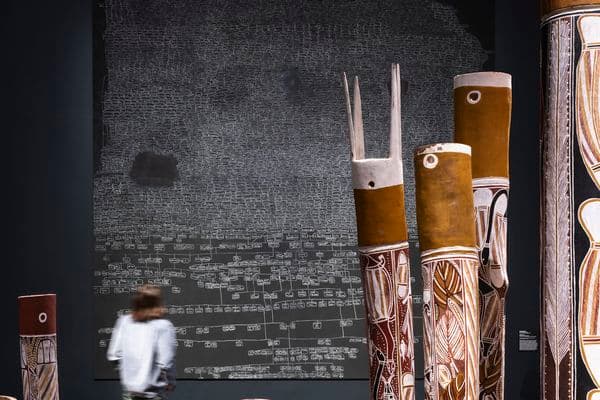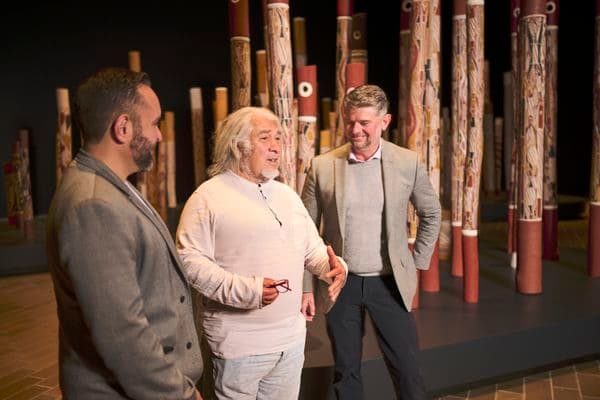Islands in the Sun
Prints by Indigenous artists of Australia and the Australasia region
17 Feb – 23 Sep 2001
About
Islands in the Sun, the first major exhibition of contemporary prints by Indigenous artists from Australia and the Australasian region, brings together a remarkable and extensive collection of prints by artists from Arnhem Land, Bathurst and Melville Islands, Torres Strait Islands, Papua New Guinea, Aotearoa New Zealand and the Pacific Islands. Also included is an innovative group of collaborative works which cross traditional geographic and cultural boundaries.
The indigenous people of the Australasian region, although belonging to different cultures, share the same history of European colonisation. All have struggled to maintain their cultural identity and throughout the 1960s and 70s many communities intensified their campaigns to reclaim their lands and cultures. Australian Aboriginal people became eligible to vote in 1967. The legal status of the Treaty of Waitangi, between the Maori and Pakeha, was upheld in 1987. In Australia in 1992, the Mabo case decided that native title should be based on traditional connection to or occupation of the land. Papua New Guinea and many of the Pacific Islands gained independence during the late 1960s and 70s.
The arts have flourished in each of these societies and there is now a renewed interest in traditional images, designs and narratives. New images and stories have also evolved, reflecting the changing times and the introduction of new technologies. Printmaking has proved vital in making the visual arts of these cultures widely accessible.
During the 1980s printmaking became a popular medium among Aboriginal artists from Arnhem Land. The cheap screenprint process enabled production of limited edition prints and printed t-shirts. Local narratives were enthusiastically adapted to the print medium and became a vehicle for the acceptance and familiarity of Aboriginal imagery in popular culture. Arnhem Land artists such as Banduk Marika are now closely involved in printmaking. Their participation has escalated in recent years as a result of adult education classes and print workshops in urban and remote communities, among them the Northern Editions Print Workshop in Darwin and the Buku Larrnggay Mulka Centre which was established at Yirrkala in 1975
For the Tiwi artists of Bathurst and Melville Islands some of the earliest forays into the print medium were simple woodcuts by artists like Bede Tungutalum, which were often used in producing fabric designs. Funding for adult education programs has subsequently assisted in the establishment of community art centres—Jilamara Art Centre was established in 1986 at Milikapiti and Munupi Arts Association at Pularumpi was incorporated in 1990. Most recently Tiwi artists Maryanne Mungatopi and Pedro Wonacamirri have participated in innovative projects with the Australian Print Workshop.
Printmaking has also become a popular and accessible medium for Torres Strait Islander artists. The establishment of courses specifically designed for Indigenous people at the Banggu Minjaany Arts and Cultural Centre at the Tropical North Queensland Institute of TAFE has enabled a new generation of Torres Strait Islander artists to experiment with the printmaking medium. Intricately detailed with traditional motifs, the skilfully refined prints of these young artists are an extension of the wood carving techniques originally used to decorate functional items and ceremonial objects. The prints of artists such as Dennis Nona, Alick Tipoti and Anne Gela blend tradition, modern society and conflict, and have become a statement of cultural affirmation and identity.
Printmaking was introduced into Papua New Guinea in the late 1960s and reached its peak of popularity in the 70s. In 1976 the National Arts School came into being and was one of the many cultural initiatives that occurred around the time of Papua New Guinea’s Independence in 1975. The prints in Islands in the Sun belong to a specific period of social, political, artistic, literary and educational change in Papua New Guinea. Created by artists from a diversity of backgrounds, including Mathias Kauage, David Lasisi and Cecil King Wungi, they present strong and vibrant images that continue to resonate.
In Aotearoa New Zealand the last two decades have witnessed an extraordinary renaissance of Maori culture, with art at the centre of this political and social process. Maori imagery has been reapproriated by contemporary Maori artists and printmakers including Paratene Matchitt, John Hovell and Robyn Kahukiwa, and affirmed as a set of emblems that expressed the spirituality and vigour of Maori people. Many Pacific Islanders have settled in Aotearoa New Zealand. Artists like John Pule and Fatu Feu’u have adapted traditional motifs to both paper and tapa cloth, using the printmaking medium as a means of expressing a common Pacific heritage. Michel Tuffery—who himself is of mixed cultural background—has encouraged printmaking by running community workshops throughout the Pacific Islands.
Islands in the Sun also brings together a group of cross-cultural collaborative works which have produced quite different kinds of ideas, images, knowledge and values. At the Northern Territory University, Indigenous and non-Indigenous Australians and Indonesian and Filipino artists worked together to communicate their ideas, beliefs and their marks through the printmaking medium. In New Zealand, Robin White worked with Fijian artist Leba Toki using large tapa cloth and plastic stencils to produce a narrative which is told through traditional and contemporary Pacific Island motifs.
Islands in the Sun is both a visually and spiritually stimulating exhibition which will contribute greatly to our understanding of contemporary indigenous art of our region. The exhibition will travel to Cairns and the region. Islands in the Sun is an NGA Travelling Exhibition in collaboration with Cairns Regional Gallery.











